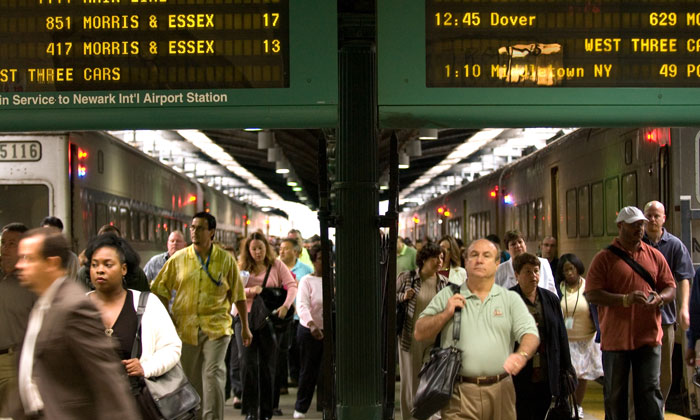Securing the future of public transport with new technology
- Like
- Digg
- Del
- Tumblr
- VKontakte
- Buffer
- Love This
- Odnoklassniki
- Meneame
- Blogger
- Amazon
- Yahoo Mail
- Gmail
- AOL
- Newsvine
- HackerNews
- Evernote
- MySpace
- Mail.ru
- Viadeo
- Line
- Comments
- Yummly
- SMS
- Viber
- Telegram
- Subscribe
- Skype
- Facebook Messenger
- Kakao
- LiveJournal
- Yammer
- Edgar
- Fintel
- Mix
- Instapaper
- Copy Link
Posted: 20 June 2018 | Brian Alberts, Polly Hanson | No comments yet
Safety and security are the number one priorities for transit agencies. In this article from the American Public Transportation Association (APTA), Brian Alberts, APTA Director of Safety, and Polly Hanson, APTA Director of Security, Risk and Emergency Management, explain how partnerships, as well as changes to policy and technology, are making mass transit safer.


SAFETY is the number one priority for the public transportation industry. It is more than an operating principle and a promise to the riders of public transit; it is the core value of every member of the American Public Transportation Association (APTA). The men and women who manage and operate public transportation systems are fully committed to the safety and security of their systems, passengers, employees, and the public. While new technology and policy continues to transform our day-to-day lives, APTA is one of the leading advocates for safety and security improvements in the U.S.
Policy changes
In a bid to improve safety cross the United States, the Federal Transit Administration (FTA) issued the State Safety Oversight (SSO) programme final rule on 16 March 2016. The implementation of this rule requires all State Safety Oversight Agencies (SSOAs) to be compliant with an SSO-certified agency by a deadline of 15 April 2019. SSOs are required to include a number of safety elements for safety certification and APTA has been working with the FTA to ensure its members are aware of this upcoming policy requirement.
Safety management systems
Another effective method for improving safety throughout the United States and Canada is the implementation of safety management systems (SMS). SMS is a management process that has been successful in the aviation industry and is currently being implemented at many public transit properties throughout North America. SMS allows agencies to make effective, risk-based decisions through hazard identification and risk analysis. This process addresses safety issues found throughout the public transit industry and includes four components: safety management policy, safety risk management, safety assurance, and safety promotion. Together, these four components help to facilitate the integration of safety as the core value in all business processes and decision-making, ensuring that transit agencies are becoming safer overall.
The implementation of SMS within a transit agency is not just the responsibility of the safety department but rather an agency-wide approach to safety in everything that they do. Many transit agencies have been implementing SMS, including: Metro Transit Minneapolis-St. Paul, The Greater Cleveland Regional Transportation Authority (GCRTA), and the Utah Transit Authority (UTA). These agencies are all located in states that have SSO programs fully certified by the FTA and are among national leaders in strengthening safety for transit passengers and workers through the implementation of SMS.
New technology
New technologies are entering the transit industry in many areas and through many different functions. APTA works with the industry to promote and support transit agencies in implementing these new transit technologies. One example currently being tested is the retrofitting of buses with an innovative collision avoidance system. The system is designed to alert bus operators of pedestrians, cyclists, and other drivers that enter the bus operator’s blind spots while driving, or before and after dropping off passengers. It adds technology to the buses that include cameras, sensors and digital displays, as well as software elements to record and report incidents, should they happen.
APTA members, like the Virginia Department of Rail and Public Transportation (DRPT) are national leaders in the promotion of collision avoidance technology within public transit.
“One of the main goals of the Department of Rail and Public Transportation is to ensure safe and reliable transportation for Virginia’s citizens, and we actively seek opportunities to implement new technology to make our transit infrastructure safer,” says DRPT Director Jennifer Mitchell. “Driver Assistance Systems are a great way to add yet another safety feature to our fleets.” The DRPT is planning to retrofit 50 buses with collisions avoidance systems in the future.
Rail technology
There are also new technologies being developed for rail transit. To maintain a safe and secure rail system, it is important to keep workers safe when working on rail right of ways (ROW). Technologies have been introduced to further enhance roadway worker protection (RWP) programmes. The Metropolitan Atlanta Transit Authority (MARTA) is one such agency; its RWP programme uses innovative and advanced technologies to mitigate the risks of accidents for transit system workers. This includes the creation, testing, and installation of bi-directional warning technologies, as well as a roadway worker location awareness system with enhanced RWP to communicate with the Rail Operations Control Center (ROCC). Some of these awareness systems use arm bands that provide an audio and visual alert to the roadway worker when an equipped train is approaching. These systems also tell the ROCC and operator where the roadway worker is located, where they entered or exited the ROW, how long they worked on the ROW, and where the train is in relationship to the roadway worker.
An important preventative safety technology measure in the rail industry is positive train control, or PTC. It is a “system designed to prevent train-to-train collisions, over speed derailments, incursions into established work zone limits, and the movement of a train through a switch left in the wrong position”, according to the Rail Safety Improvement Act of 2008. Railroads have begun the installation and testing of PTC systems over the complicated network of railroads, while still providing the same service to passengers and customers across the country.
Technology advances
Transit agencies are looking towards the future of transportation safety and security. The Transportation Security Administration (TSA) has been testing a new screening technology that can identify objects that block naturally occurring emissions from a person’s body and will trigger an alarm if an individual is carrying an improvised explosive device. This new screening technology can scan large crowds at a distance, is portable and can be mounted on walls or ceilings. It does not emit radiation, and to protect privacy, doesn’t display a person’s anatomical details.
In a statement, TSA Administrator David Pekoske noted: “Along with industry partners, we are committed to identifying, testing, and deploying technology that addresses threats to transportation across the spectrum.” This technology can help combat the growing terrorist threat within the mass transit industry. Transit agencies have been working closely with TSA to test or pilot this technology within their own systems, including Los Angeles Metro, the Washington Metropolitan Area Transit Authority in Washington DC, The Bay Area Rapid Transit system in the San Francisco Bay Area, and New Jersey Transit. Alex Wiggins, Chief System Security and Law Enforcement Officer for LA Metro, explains: “We will continue to evaluate various technologies, with possible implementation of a new passenger screening system this year. Transit agencies have to remain vigilant in seeking out the latest technologies to meet evolving transit security threats.”
Safety and security is more than an operating principle and promise to passengers; it is a core value of every transit agency in North America. APTA prioritises safety and security through the nationwide implementation of SMS and new, innovative technologies such as transit right of way worker protection, positive train control, and various security related technologies. APTA stands ready to assist the industry with improving safety and security through current and future technologies.
ACKNOWLEDGEMENTS
Christopher Stadler, APTA Safety and Security Intern, also contributed to this article.
Biography




Related topics
Transport Governance & Policy, Vehicle & Passenger Safety
Issue
Issue 2 2018
Related cities
United States of America
Related organisations
American Public Transportation Association (APTA)
Related people
Brian Alberts, David Pekoske, Jennifer Mitchell, Polly Hanson







